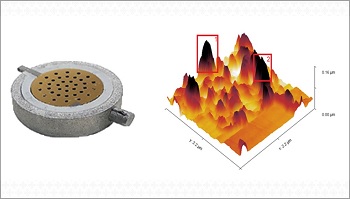New method for chemical characterization of lithium-oxygen batteries at the nano scale

In an paper in the high-impact journal Advanced Energy Materials, researchers from CINE and collaborators present a new method, faster and more accurate than those used so far, to study lithium-oxygen (Li-O2) batteries. The method sheds new light on the chemical reactions that take place in these promising devices.
Lithium-oxygen batteries can be the key to storing energy on a large scale (for example, in wind or solar farms), as they have the best relationship between their weight and the amount of energy they can store. However, this technology still does not reach the necessary durability for commercialization.
One of the reasons is the formation of unwanted compounds that can occur during battery discharge, leading to the degradation of its components and failure. To understand this point, it is necessary to remember that the ability of these devices to store and release energy is based on the reaction of lithium from the anode with oxygen that diffuses through the cathode. This reaction forms compounds such as lithium peroxide (Li2O2), which decomposes when the battery recharges. And everything starts again in the following discharge.
As the source of oxygen in these devices is usually the air itself (abundant, free and easy to capture), carbon dioxide and water that end up entering the battery can intervene in the reactions and generate harmful compounds. Furthermore, the use of catalysts in the battery can also impact these reactions by introducing new elements.
In this context, a group of researchers from CINE, from the Advanced Energy Storage division, has been dedicating efforts to developing the most adequate methods and equipment to understand the formation of these chemical compounds (so-called “discharge products”) in devices.
In this new study, the researchers used the technique of infrared spectroscopy, which explores the interactions between infrared radiation and matter to identify chemical substances. In order to reach the nanometric scale, they used radiation from synchrotron light in experiments carried out at the Brazilian synchrotron source (LNLS/CNPEM).
The authors combined two types of complementary experiments. To study the chemical changes at the micrometric scale, they performed the measurements while the battery was discharging (in operando). At the nanometric scale, experiments of this type were not possible, and the team opted for in situ analysis (that is, using the battery itself as a sample, but without it being in operation). This combination allowed obtaining more solid results, as well as proving the feasibility of using infrared spectroscopy at the nanoscale for the study of Li-O2 batteries.
“The main contribution of this work was to create a form of analysis of Li-O2 batteries that allows a local chemical characterization of a few nanometers by infrared spectroscopy that has never been done before”, summarizes Professor Gustavo Doubek (UNICAMP), researcher at CINE. “The usual infrared characterization techniques only give us average information over a larger area and thus we are not able to know exactly which materials are responsible for the alterations we observe”, explains Doubek, who coordinated the research.
Among other results, the work showed that the discharge products are distributed homogeneously in the nano and micro scales, and that the presence of carbon dioxide and water generates other compounds in addition to those desired for battery operation. Furthermore, the in situ technique at the nanoscale identified the degradation of the battery’s electrolyte in the first minutes of operation, a fact that, with other techniques, was only measurable after many hours of experiments.
Scientific paper reference: In Situ Infrared Micro and Nanospectroscopy for Discharge Chemical Composition Investigation of Non-Aqueous Lithium–Air Cells. Thayane CM Nepel, Chayene G. Anchieta, Leticia F. Cremasco, Bianca P. Sousa, André N. Miranda, Lorrane CCB Oliveira, Bruno AB Francisco, Julia P. de O. Julio, Francisco CB Maia, Raul O. Freitas, Cristiane B. Rodella, Rubens M. Filho, Gustavo Doubek. Adv. Energy Mater. 2021, 2101884. Adv. Energy Mater. 2021, 2101884. https://doi.org/10.1002/aenm.202101884
Authors of the article who are members of CINE: Thayane CM Nepel (postdoc at UNICAMP), Chayene G. Anchieta (postdoc at UNICAMP), Leticia F. Cremasco, (doctoral student at UNICAMP), Bianca P. Sousa (doctoral student at UNICAMP), UNICAMP), André N. Miranda (doctoral student at UNICAMP), Lorrane CCB Oliveira (doctoral student at UNICAMP), Bruno AB Francisco (master’s student at UNICAMP), Julia P. de O. Júlio (master’s student at UNICAMP), Rubens M. Filho (professor from UNICAMP and principal investigator of the research division at CINE) and Gustavo Doubek (professor at UNICAMP and researcher at CINE).
Contact

Gustavo Doubek
UNICAMP - Brasil











